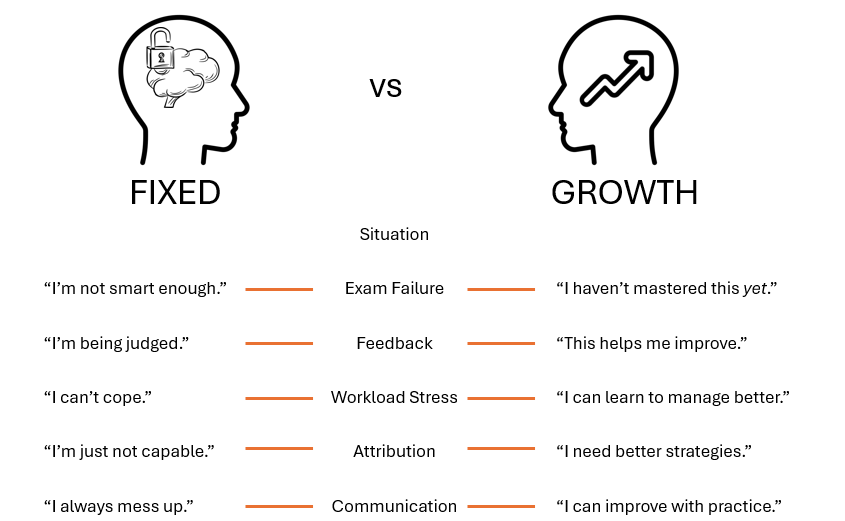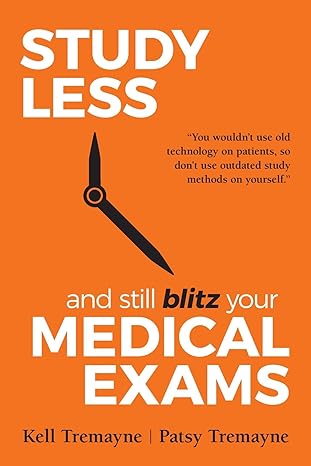- Home
- What Is a Mindset
- Fixed vs Growth Mindset
Growth Mindset versus Fixed Mindset: Thrive as a Junior Doctor
As a junior doctor, you’re no stranger to pressure. Between long shifts, relentless study, and the emotional toll of patient care, it can feel like you’re constantly sprinting uphill. And when exams loom, the stakes feel even higher. But what if the key to surviving - and thriving - wasn’t just how hard you work, but how you think? This is where the concept of growth mindset versus fixed mindset becomes crucial.
Your mindset - how you interpret challenges, setbacks, and feedback - can shape not only your exam performance but your entire experience of training and clinical life.
A growth mindset is the belief that your abilities—whether clinical, academic, or interpersonal—can be developed through effort, feedback, and learning. In contrast, a fixed mindset assumes that your intelligence and talent are static. You either have it, or you don’t.

This distinction isn’t just theoretical.
In our work with hundreds of junior doctors, we’ve seen how the growth mindset versus fixed mindset paradigm influences everything:
- how you respond to failure,
- how you study,
- how you cope with stress, and
- how you grow into the doctor you want to be.
Let’s explore how these mindsets play out in real life.
Growth Mindset versus Fixed Mindset Reactions
Below are some common responses differ across the two mindsets.

Here are some real-life examples of doctors that we have worked with.
Fixed Mindset in Action: When Failure Feels Final
The below are real examples of some of the doctors we have worked with. Names are changed and the story has been changed to maintain anonymity.
Meet Chiama. She’s in an anaesthetics training program. On paper, she had everything going for her—access to tutorials, a supportive supervisor, and a clear pathway to Fellowship. But she kept putting off her primary exam. “I’m just not a problem-solving type,” she’d say, brushing off encouragement from colleagues.
Eventually, her supervisor insisted she sit the exam. She failed both the multiple-choice and short-answer sections. Instead of seeing this as a learning opportunity, Chiama blamed external factors: “I was a bit off that day,” she told friends. She attended one tutorial for the next sitting, but after receiving constructive feedback on her reasoning, she felt criticised and stopped attending altogether. “It’s not my fault if I fail,” she said. “Everyone’s pushing me when I’m not ready.”
Chiama sat the exam again. She failed. And then she dropped out of the program.
Her story is a textbook example of the fixed mindset. For Chiama
- She believed her abilities were static - unchangeable traits rather than skills to be developed.
- Feedback felt like a personal attack, not a tool for growth.
- Challenges were threats, not opportunities.
In the growth mindset versus fixed mindset framework, Chiama’s thinking kept her stuck, disengaged, and ultimately led her to abandon a promising career path.
Growth Mindset in Action: Mohammed’s Story
Mohammed started his journey in a less-than-ideal setting: an unaccredited junior registrar role in a small private hospital. He worked night shifts, had minimal supervision, and saw little variety in patient presentations. Many would have seen this as a dead end. Mohammed saw it as a stepping stone.
He knew he had a lot to learn, and he embraced the challenge. He volunteered for extra shifts during the day to gain exposure to different cases and actively sought feedback from consultants. He didn’t let the lack of structure deter him - instead, he created his own learning opportunities.
Mohammed’s mindset was unmistakably growth-oriented. He believed
- that effort mattered,
- that feedback was valuable, and
- that improvement was possible.
Over time, his skills grew, his confidence increased, and he was rotated to a larger teaching hospital where he thrived.
In the growth mindset versus fixed mindset model, Mohammed exemplifies the power of believing in development. He didn’t wait for perfect conditions - he made the most of what he had. His story shows that mindset isn’t just about optimism; it’s about action, persistence, and resilience.
How to Cultivate a Growth Mindset
1. Reframe Failure
Failure isn’t the opposite of success—it’s part of it.
Michael Jordan missed over 9,000 shots.
Thomas Edison failed 1,000 times before inventing the lightbulb.
Doctors fail too. In fact, failure rates in some specialty exams are as high as 50%.
The difference is how you respond.
Try this: when you catch yourself thinking, “I can’t do this,” add one word—yet. “I can’t do this… yet.” That tiny shift opens the door to growth and reframes your experience through the lens of a growth mindset. Here are some more ideas on how to combat fear of failure with a growth mindset.
2. Challenge Your Inner Narrator
Your thoughts shape your reality. If you tell yourself, “I’m not smart enough,” your brain will look for evidence to prove it. Instead, ask: “What can I learn from this?” or “What strategy could I try next?”
In our book, Study Less, we call this attribution retraining—shifting from blaming fixed traits (“I’m just not good at exams”) to focusing on controllable factors (“I need a better study plan”). This is a practical way to shift from a fixed mindset to a growth mindset—the core of the growth mindset versus fixed mindset model.
Here are some common thinking traps that are popular amongst junior doctors.
3. Use Adaptive Coping Strategies
When things go wrong, how do you cope?
- Maladaptive: Rumination, self-blame, avoidance, denial.
- Adaptive: Planning, seeking support, active problem-solving.
After a failure, it’s tempting to binge Netflix or disappear from tutorials. But long-term success comes from facing the discomfort, not avoiding it. Talk to someone. Make a plan. Take a breath - and then take action.
4. Study Smarter, Not Harder
A growth mindset isn’t just about attitude—it’s about strategy.
- Use spaced repetition to flatten the forgetting curve.
- Practice retrieval by testing yourself, not just re-reading.
- Shift from passive reading to active engagement - ask questions, make connections, and teach others.
As we say in the book:
“You wouldn’t use outdated technology on patients—so don’t use outdated study methods on yourself.”
This is where the growth mindset versus fixed mindset distinction becomes practical: one leads to innovation and efficiency, the other to burnout and stagnation.
5. Track Your Progress
Keep a training diary. Each day, rate
- your wellbeing,
- study quality, and
- mindset.
Celebrate small wins. Reflect on what’s working. This builds self-awareness and reinforces the belief that progress is possible.
Final Thoughts: You Are Not Your Exam Result
The growth mindset versus fixed mindset distinction doesn’t just help you pass exams - it helps you become a better doctor. That is why it is so important on taking steps to change your mindset.
It helps you:
- Accept feedback without defensiveness.
- Stay calm under pressure.
- Bounce back from setbacks.
- Support your colleagues with empathy.
- Lead with confidence and humility.
- And perhaps most importantly, it helps you protect your wellbeing in a system that often doesn’t.
You are more than your last mark. More than your last shift. More than your last mistake.
You are a work in progress—and that’s a good thing.
So the next time you feel overwhelmed, remember: your brain is a muscle. Your mindset is a choice. And your future is still being written.
Choose growth.






